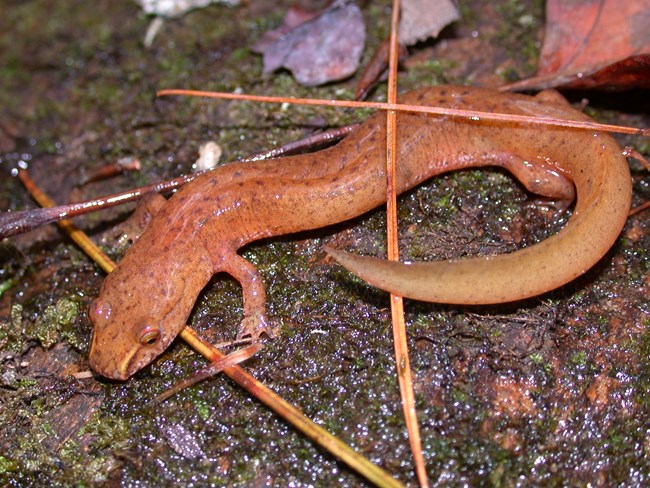
NPS Photo Family: Plethodontidae Gyrinophilus porphyriticus Spring Salamander
Size: 10.8 to 23.2 cm long (4 ¼" to 9 ¼") General Description: Salmon, brownish-pink, yellowish-brown, orange or reddish brown in color with variable patterns: spotting, mottled, cloudy, vague dark markings or netlike patterns. Light stripe or bar runs from eye to nostril (along raised ridge called canthus rostralis), often bordered below by a gray color, although border color may appear vague. Stout body. Tail keeled. 17 to 19 costal grooves. Larvae are aquatic and have stream-type morphology. Juveniles are typically more brightly colored than adults. Similar Species: Red Salamanders, Pseudotriton ruber, tends to be redder in color, the head is more rounded, there is no light line from the eye to the nostril, and typically the patterning is darker. Reproduction: Suspected to breed in fall and spring, but documentation knowledge of this is limited. Habitat: Prefers shady wet areas with clear running water; springs, clear mountain brooks, seepages, wet caves. Typically found from 91 to 2,012 m in elevation (300 to 6,600'). Behavior: Typically more active at night. Adults will coil body into a ring when attacked. The can produce a noxious skin secretion that is effective in repelling attack by shrews. During winter or when drought conditions occur, adults will move to underground retreats. Larvae are often found in gravely or stony creek beds or under debris and are typically more active at night. It is suggested that this species is part of a Müllerian mimicry involving Pseudotritons and Notophthalmus viridescens red eft stage.
|
Last updated: April 14, 2015
